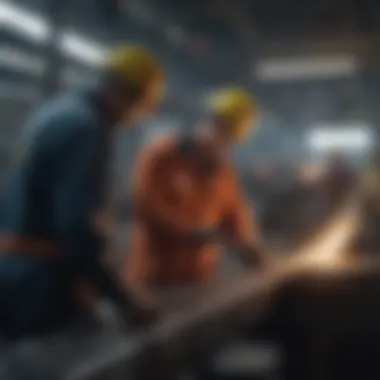Exploring the Impact of Steel Industry on Employment Opportunities


Budgeting Techniques
In the realm of employment opportunities, understanding budgeting techniques is paramount. Creating a personal budget acts as the cornerstone of financial stability. By meticulously outlining income and expenses, individuals gain a clear perspective on their financial standing. Tracking expenses effectively allows for real-time monitoring of spending patterns, enabling informed decisions for better financial management. Moreover, setting realistic financial goals provides a roadmap towards achieving desired outcomes, aligning monetary resources with long-term aspirations.
Savings Strategies
When delving into the intricacies of the steel industry's impact on job creation, implementing savings strategies proves instrumental. Building an emergency fund serves as a financial safety net during unforeseen circumstances. Automating savings contributions streamlines the process, ensuring consistent progress towards financial objectives. Exploring different saving accounts allows for optimized savings potential, each catering to unique needs and preferences.
Smart Spending Tips
Navigating the nuances of employment opportunities bolstered by the steel industry involves adopting smart spending practices. Distinguishing between needs and wants cultivates mindful expenditure habits, fostering financial prudence. Leveraging cashback and rewards programs transforms routine purchases into opportunities for savings and rewards accumulation. Additionally, comparison shopping for significant purchases aids in securing the best value for every expenditure.
Investment Insights
In the context of job growth within the steel sector, grasping investment insights is imperative. Understanding different investment options facilitates informed decision-making tailored to individual risk tolerance and financial goals. Diversifying investment portfolios mitigates risk and enhances potential returns, a strategic approach to wealth accumulation. Effectively managing risk and return balances the investment landscape, optimizing financial growth.
Financial Planning for the Future
Looking towards the horizon of employment potential in the steel industry necessitates meticulous financial planning. Mastering retirement planning basics lays the foundation for a secure financial future post-work life. Considering estate planning implications ensures smooth wealth transfer and asset protection for future generations. Regularly reviewing and adjusting financial plans guarantees alignment with evolving goals and market conditions, fortifying financial resilience.
Introduction
In this crucial section of the article, we delve into the intricate relationship between the steel industry and employment opportunities, a topic of immense relevance in today's economic landscape. The steel industry stands as a stalwart pillar, not just in production but also in the creation of numerous job openings globally. Understanding the impact of the steel sector on employment is essential for grasping the broader implications that reverberate across various industries and regions. As we explore this dynamic connection, we uncover the multifaceted ways in which steel production influences job markets, wages, and overall economic stability


Understanding the Steel Industry
The steel industry stands as a foundational pillar in the tapestry of global economies. Exploring the mechanisms behind steel production unveils a labyrinth of interconnected processes that contribute to shaping employment landscapes worldwide. Understanding the steel industry delves into not just the metallurgical aspects but also the socio-economic implications that reverberate across various sectors.
Historical Evolution of Steel Production
The story of steel production unfolds like a tapestry woven through the annals of human history. From the primitive smelting techniques of antiquity to the sophisticated blast furnaces of modern times, the evolution of steel production mirrors the progress of civilizations. This evolution transcends mere technological advancement, embodying a narrative of human ingenuity, innovation, and industrial revolution.
Key Players in the Global Steel Market
In the expansive theater of the global steel market, key players emerge as titans, shaping trends and steering the course of industry dynamics. Steel conglomerates and emerging players wield significant influence, not only in driving production capacities but also in dictating market trends and trade patterns. Understanding the strategic maneuvers and market positioning of these key players illuminates the power structures within the global steel ecosystem.
Technological Advancements in Steel Manufacturing
The realm of steel manufacturing stands at the frontier of technological innovation. Advancements in materials science, automation, and sustainability practices redefine the contours of traditional steel production. From advanced recycling techniques to novel alloy discoveries, technology catalyzes efficiency gains and environmental stewardship in the steel manufacturing process. Navigating the nuances of these technological advancements offers a glimpse into the future landscape of steel industry operations.
Impact on Employment
The discussion on the impact of the steel industry on employment opportunities is of paramount importance within the realm of this article. Understanding how the steel sector influences job creation and economic dynamics is crucial in comprehending the intricate relationship between industrial production and workforce expansion. This section delves into specific elements such as employment trends, the significant contribution of the steel industry to job creation, and addressing regional disparities in steel-related employment. By dissecting these aspects, we can unravel the multifaceted effects of steel production on employment landscapes, providing valuable insights into the complex interplay between industry shifts and workforce implications.
Employment Trends in the Steel Industry
Examining the employment trends within the steel industry unveils a nuanced narrative of evolving workforce dynamics. From traditional manual labor to modern-day technology-driven roles, the sector has undergone transformative changes that reflect broader economic shifts. The rise of automation, skill upgradation requirements, and the demand for specialized expertise are shaping the future trajectory of steel industry jobs. By exploring these trends, we gain a holistic view of how employment structures within the steel sector are adapting to global market influences, paving the way for a more agile and specialized workforce.
Steel Industry's Contribution to Job Creation


The steel industry stands as a stalwart in the realm of job creation, playing a pivotal role in bolstering employment opportunities across various skill levels. By fostering a diverse range of positions spanning manufacturing, logistics, engineering, and management, the sector fuels both direct and ancillary job growth. Understanding the industry's contribution to job creation involves delving into the symbiotic relationship between steel enterprises and labor markets. Analyzing the mechanisms through which the steel industry generates employment sheds light on its significance as a cornerstone of economic vitality and workforce sustainability.
Regional Disparities in Steel-Related Employment
Navigating the landscape of regional disparities in steel-related employment unravels a tapestry of varying socio-economic conditions and industrial capacities. Certain regions may thrive on robust steel production, creating abundant job opportunities, while others face challenges stemming from market dynamics or resource limitations. Addressing these disparities requires a nuanced approach that considers factors such as infrastructure development, labor market flexibility, and regulatory frameworks. By illuminating the disparities in steel-related employment across different regions, we can foster a deeper understanding of the localized impacts of the steel industry on economic ecosystems.
Challenges and Opportunities
In the realm of the steel industry's impact on employment opportunities, delving into the myriad challenges and opportunities it presents unveils a nuanced landscape. Recognizing the significance of addressing challenges and seizing opportunities is paramount in fostering sustainable growth in this sector. Challenges may encompass aspects such as technological disruptions, shifting market demands, and evolving consumer preferences. These dynamics necessitate a proactive approach to innovation and adaptation within the industry. On the flip side, opportunities arise from embracing automation, enhancing efficiency, and capitalizing on emerging trends. By strategically navigating these challenges and maximizing opportunities, the steel industry can fortify its position as a key contributor to job creation and economic development.
Automation Impact on Steel Jobs
The escalating integration of automation within the steel industry has redefined the nature of steel jobs. Automation technologies, including robotics and artificial intelligence, have streamlined production processes, optimized efficiency, and bolstered output levels. While automation holds the promise of enhanced productivity and cost-efficiency, it also prompts concerns about potential job displacement. The transition towards automation necessitates a concerted effort towards reskilling and upskilling the existing workforce to align with the evolving demands of the industry. Balancing the benefits of automation with the imperative to safeguard existing jobs poses a crucial challenge for stakeholders in the steel sector.
Training and Upskilling Initiatives for Steel Workers
Recognizing the imperative of equipping steel workers with the requisite skills for the digital age, training and upskilling initiatives have assumed critical importance. These programs aim to bridge the skills gap, enhance technological literacy, and cultivate a versatile workforce capable of navigating the complexities of modern steel production processes. By investing in comprehensive training platforms and upskilling schemes, stakeholders can empower steel workers to embrace innovation, adapt to technological advancements, and foster a culture of continuous learning within the industry.
Diversification of Steel Industry for Sustainable Employment
As the landscape of employment in the steel industry evolves, diversification emerges as a vital strategy for ensuring sustainable growth and resilience. Diversifying the portfolio of steel products, exploring new market segments, and integrating sustainability practices can enhance the industry's capacity to weather market fluctuations and mitigate risks associated with overreliance on specific product lines. By fostering a culture of innovation, embracing diversification, and adapting to changing market dynamics, the steel industry can position itself as a dynamic hub of employment generation and economic prosperity.
Government Policies and Interventions
Exploring the intricate realm of Government Policies and Interventions in the realm of the steel industry's impact on employment opportunities opens a doorway to understanding the regulatory framework dictating this crucial interplay. Crucially, governmental interventions play a pivotal role in shaping the landscape for job creation within the steel sector, steering the course of employment trends and fostering a conducive environment for sustainable growth. By delving into the specifics of how governments across different geographies employ policies to bolster or adjust the steel workforce, one gains insight into the broader economic strategies at play.


Role of Government in Supporting Steel Workforce
Within the overarching theme of government involvement in the steel industry's employment dynamics, the 'Role of Government in Supporting Steel Workforce' stands out as a beacon of influence and direction. Governances steps into the realm of workforce support ranging from training programs and incentivization schemes to regulatory frameworks that safeguard the well-being of steelworkers. The considerations revolve around balancing the interests of industry players, ensuring fair labor practices, and adapting to evolving market demands to enhance the industry's employment sustainability.
Trade Policies Impacting Steel Jobs
Similarly, 'Trade Policies Impacting Steel Jobs' delve deep into how global trade dynamics, tariffs, and international agreements can sway the direction of employment opportunities within the steel industry. Trade policies dictate the competitiveness of domestic steel products against imports, thereby influencing the demand for local labor. By illuminating the nuanced relationship between trade regulations and job numbers in the steel sector, one uncovers the complexities that underpin the employment landscape in this critical industry.
Incentives for Steel Industry Growth and Employment
Moreover, 'Incentives for Steel Industry Growth and Employment' shed light on the mechanisms through which governments incentivize and foster growth within the steel sector to bolster job creation. Incentives can take various forms, from tax breaks for steel manufacturers to subsidized training programs for steelworkers. By dissecting the effectiveness of these incentives and their impact on employment numbers, one can gauge the efficacy of government-led initiatives in propelling the growth and sustainability of steel-related jobs.
Future Outlook and Projections
Future Outlook and Projections analyze the trajectory in which the steel industry's employment landscape is heading. This section goes beyond the present scenario to forecast potential developments, key trends, and challenges that could shape job opportunities in the steel sector. Understanding the Future Outlook is crucial for stakeholders - from policymakers to industry players and job seekers. By anticipating shifts in demand, technological advancements, and global economic trends, stakeholders can better prepare for the evolving job market. Examining the Projections provides valuable insights into anticipated growth areas, areas of concern, and the overall health of the steel job market. This detailed analysis equips readers with a strategic outlook to navigate the complexities of the industry landscape.
Emerging Trends in Steel Job Market
In the ever-evolving steel industry, staying abreast of Emerging Trends is paramount for individuals and organizations seeking to capitalize on new opportunities. This subsection delves into the latest developments reshaping job roles, skill requirements, and recruitment practices within the steel sector. From the integration of digital technologies to the rise of sustainable practices, understanding these Emerging Trends is essential for maintaining competitiveness and relevance. By exploring how the job market is adapting to external influences and internal dynamics, readers gain a comprehensive understanding of the forces driving change within the industry.
Forecast for Steel Employment Opportunities
Forecast for Steel Employment Opportunities offers a forward-looking perspective on the availability and nature of jobs within the steel sector. This predictive analysis takes into account factors such as market demand, technological disruptions, and policy developments that could impact job creation and retention. By outlining potential scenarios for future employment trends, this subsection aids readers in strategic planning and decision-making. Whether discussing growth sectors, skills in demand, or potential challenges, the Forecast provides a roadmap for navigating the evolving job landscape.
Adapting to Changing Dynamics of Steel Industry Jobs
Adapting to Changing Dynamics of Steel Industry Jobs addresses the imperative need for individuals and organizations to remain agile in response to industry shifts. This section highlights the importance of upskilling, reskilling, and embracing flexibility in roles to thrive in a changing environment. By recognizing and adapting to new technologies, market demands, and workplace practices, stakeholders can proactively shape their career trajectories. Understanding the evolving dynamics enables readers to future-proof their skills and secure sustainable employment in a rapidly transforming industry.
Conclusion
In delineating the expansive domain of the forces steering the domain of steel industry on employment creation, the Conclusion emerges as a pivotal cavalcade converging the multifarious strands of this discourse. Comprehending the interconnectedness between the historical evolution of steel production, the contemporary technocratic frontiers peppered with the dominance of key global players, and the emergent employment lifelines sculpted by the industry crackling with technological advancements metamorphoses into an enlightening odyssey. Unveiling the lineage of steel-engendered employment synergies fortifies the reader's acumen, melding the past, present, and future projections into an intricate tapestry. Emphasizing the imperative diktats of the steel industry illuminates the trajectory navigated by employment trends, seminal to grasping the tempestuous quandaries tethering the unison of steel and employment. The Conclusion transcends a mere summation, instead enunciating a clarion call to decipher the entwined destinies choreographed by the steel industry and the pantheon of opportunities it bequeaths. Unveiling the future horizons while anchoring within the bedrock of historical genesis portrays a holistic rendition of the enigmatic symbiosis between steel and human capital, pulsating within the realms of job creation and economic fortitude.







